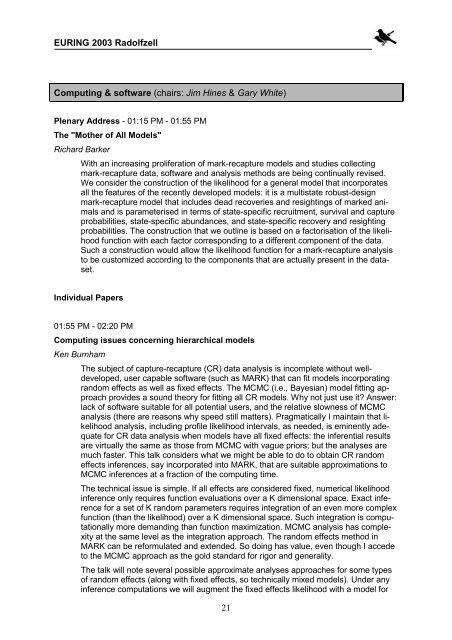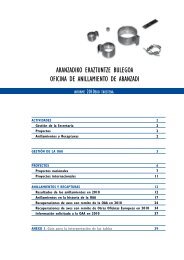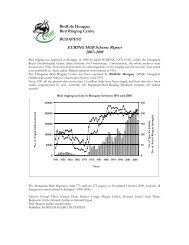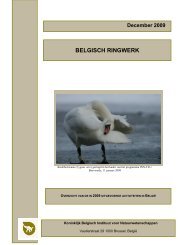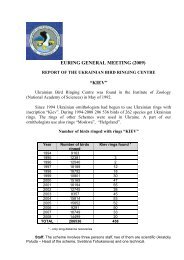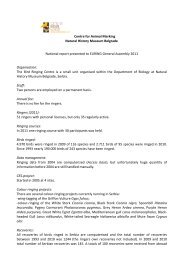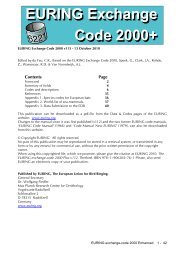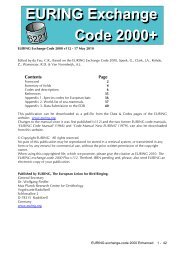The quantitative study of marked individuals in ecology, evolution ...
The quantitative study of marked individuals in ecology, evolution ...
The quantitative study of marked individuals in ecology, evolution ...
You also want an ePaper? Increase the reach of your titles
YUMPU automatically turns print PDFs into web optimized ePapers that Google loves.
EURING 2003 Radolfzell<br />
Comput<strong>in</strong>g & s<strong>of</strong>tware (chairs: Jim H<strong>in</strong>es & Gary White)<br />
Plenary Address - 01:15 PM - 01:55 PM<br />
<strong>The</strong> "Mother <strong>of</strong> All Models"<br />
Richard Barker<br />
With an <strong>in</strong>creas<strong>in</strong>g proliferation <strong>of</strong> mark-recapture models and studies collect<strong>in</strong>g<br />
mark-recapture data, s<strong>of</strong>tware and analysis methods are be<strong>in</strong>g cont<strong>in</strong>ually revised.<br />
We consider the construction <strong>of</strong> the likelihood for a general model that <strong>in</strong>corporates<br />
all the features <strong>of</strong> the recently developed models: it is a multistate robust-design<br />
mark-recapture model that <strong>in</strong>cludes dead recoveries and resight<strong>in</strong>gs <strong>of</strong> <strong>marked</strong> animals<br />
and is parameterised <strong>in</strong> terms <strong>of</strong> state-specific recruitment, survival and capture<br />
probabilities, state-specific abundances, and state-specific recovery and resight<strong>in</strong>g<br />
probabilities. <strong>The</strong> construction that we outl<strong>in</strong>e is based on a factorisation <strong>of</strong> the likelihood<br />
function with each factor correspond<strong>in</strong>g to a different component <strong>of</strong> the data.<br />
Such a construction would allow the likelihood function for a mark-recapture analysis<br />
to be customized accord<strong>in</strong>g to the components that are actually present <strong>in</strong> the dataset.<br />
Individual Papers<br />
01:55 PM - 02:20 PM<br />
Comput<strong>in</strong>g issues concern<strong>in</strong>g hierarchical models<br />
Ken Burnham<br />
<strong>The</strong> subject <strong>of</strong> capture-recapture (CR) data analysis is <strong>in</strong>complete without welldeveloped,<br />
user capable s<strong>of</strong>tware (such as MARK) that can fit models <strong>in</strong>corporat<strong>in</strong>g<br />
random effects as well as fixed effects. <strong>The</strong> MCMC (i.e., Bayesian) model fitt<strong>in</strong>g approach<br />
provides a sound theory for fitt<strong>in</strong>g all CR models. Why not just use it? Answer:<br />
lack <strong>of</strong> s<strong>of</strong>tware suitable for all potential users, and the relative slowness <strong>of</strong> MCMC<br />
analysis (there are reasons why speed still matters). Pragmatically I ma<strong>in</strong>ta<strong>in</strong> that likelihood<br />
analysis, <strong>in</strong>clud<strong>in</strong>g pr<strong>of</strong>ile likelihood <strong>in</strong>tervals, as needed, is em<strong>in</strong>ently adequate<br />
for CR data analysis when models have all fixed effects: the <strong>in</strong>ferential results<br />
are virtually the same as those from MCMC with vague priors; but the analyses are<br />
much faster. This talk considers what we might be able to do to obta<strong>in</strong> CR random<br />
effects <strong>in</strong>ferences, say <strong>in</strong>corporated <strong>in</strong>to MARK, that are suitable approximations to<br />
MCMC <strong>in</strong>ferences at a fraction <strong>of</strong> the comput<strong>in</strong>g time.<br />
<strong>The</strong> technical issue is simple. If all effects are considered fixed, numerical likelihood<br />
<strong>in</strong>ference only requires function evaluations over a K dimensional space. Exact <strong>in</strong>ference<br />
for a set <strong>of</strong> K random parameters requires <strong>in</strong>tegration <strong>of</strong> an even more complex<br />
function (than the likelihood) over a K dimensional space. Such <strong>in</strong>tegration is computationally<br />
more demand<strong>in</strong>g than function maximization. MCMC analysis has complexity<br />
at the same level as the <strong>in</strong>tegration approach. <strong>The</strong> random effects method <strong>in</strong><br />
MARK can be reformulated and extended. So do<strong>in</strong>g has value, even though I accede<br />
to the MCMC approach as the gold standard for rigor and generality.<br />
<strong>The</strong> talk will note several possible approximate analyses approaches for some types<br />
<strong>of</strong> random effects (along with fixed effects, so technically mixed models). Under any<br />
<strong>in</strong>ference computations we will augment the fixed effects likelihood with a model for<br />
21


